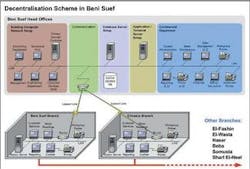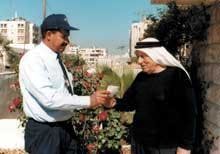Challenges in implementing billing and customer services systems in Egypt
By Mohammed Rial Ahsan, Stelios Agrotis
As part of a major water conservation campaign, the Egyptian government, US Agency for International Development and the Dutch government embarked on a program to restructure water and sewerage authorities in Fayoum, Beni-Suef and Minia under the Middle Egypt Utility Institutional Strengthening Program (MEUISP). This program is expected to increase billing and collection to 100% of water operation and maintenance (O&M) costs and 50% of wastewater O&M costs, reduce unaccounted-for-water to 30% and increase the number of metered connections to 80% of all connections in urban areas.
Over the past 18 months Hydro-Comp Enterprises has successfully installed and implemented integrated revenue and customer information systems in three Middle Egypt water authorities. A number of interesting challenges had to be overcome during implementation:
• geographic vastness of the region;
• decentralisation of systems;
• communication with remote offices;
• lack of computer literacy by a significant portion of users;
• organisation restructuring to accommodate computerised systems;
• conversion of legacy data from a previous billing system in one case;
• change management issues regarding acceptance of the systems by sceptical users.
Despite all of these challenges, the systems were implemented on schedule and are currently in productive use with additional systems in the process of being implemented.
Hydro-Comp Enterprises installed and implemented an integrated bilingual Arabic/English EDAMS Billing & Customer Information system based on Oracle database and Windows 2000 server and provided associated consulting/implementation services to the water and sewerage utilities in Fayoum, Minia and Beni Suef from 10 July 2001 until 30 October 2002.
The billing and customer service system in the three authorities serves approximately 300,000 connections in Fayoum, 400,000 connections in Minia and 250,000 connections in Beni Suef. Staff training in the utilities covered different revenue modules and functions, including system administration, meter reading, customer service, financial service, billing, meter maintenance, debt management, reporting and system maintenance.
Implementation challenges
The vastness of the project area presented a significant challenge. The three Middle Egypt governorates are located southwest of Cairo in a region that forms the heartland of Egyptian cotton and fruit production. Fayoum, with a population of 1.9 million dwellings in five cities and 163 villages, produces 230,000 m3 of potable water per day with an average of 115 litres per capita.
Minia has a population of 3.3 million dwellings in nine cities, 57 stations and 1,429 sub-villages in an area of 56,587 Km2. Minia produces 258,000 m3 of potable water and distributes about 77 litres per person.
Beni Suef has a population of 1.86 million dwellings in seven cities, 220 villages and 686 sub-villages with a total potable water supply of 224,000 m3 per day in an area of 7,000 km2.
Water meter readers are required to physically read meters, document them and bring the information back to local authorities.
The biggest challenge facing the continuity and sustainability of the new billing system is the "sense of ownership" of the new computer applications among system users, operators and the beneficiaries of the systems' outcome. The "fear factor" of losing jobs was one of the most challenging aspects of this implementation. Hydro-Comp created a "Shadow Group" from within each operational department that would support implementation activities alongside Hydro-Comp's expert team. These shadow groups were, in fact, the selected high potential staff that would sustain the knowledge and know-how of the new systems. They were trained from day one to become an integral part of the systems' implementation.
Centralisation versus decentralisation is a critical issue and a debate has been ongoing for quite sometime as to what these words really mean and how the EDAMS computer system handles the issue. The debate in this project really rests on the degree to which responsibilities vested in the chairman can be delegated (not decentralised) to regional managers.
Hydro-Comp arrived at a hybrid solution. The main database rests at the head office of each authority. A copy of the database is copied to the regional office once a month so that offline functions can operate. The main database is updated daily for work done on offline functions on a batch mode. The temporary database at the region is basically up to date with regard to transactions that were carried out at the region.
Many users of the system were not computer literate or might not have seen computers at all, especially in the out-reach locations at the rural areas. To many, computers were a weapon of downsizing and privatisation, representing job loss. Theoretical and hands-on training provided enough knowledge to run computer applications and maintain the systems; however the long-term risk is that computer-trained employees will leave for the private sector, which pays salaries almost five times higher than the public sector.
The road forward
Water authorities in the three governorates now work more as a corporation entity with better management and better accountability rather than a local municipal authority. Some of the benefits that have been shown in the recent past are due to courageous and bold steps of management in reorganising various units and doing things differently despite resource constraints.
Most of the unaccounted for water (UFW) in this region that ran as high as 50% was initially blamed as structural losses to the system and considered unrecoverable, but a steady improvement in the billing systems and revenue analysis systems revealed that the collections of revenue that remained unaccounted for and the supplied water that did not get billed constituted quite a big portion of UFW. Computerising the billing and revenue processes in some areas led to an increase in billed revenues and collection. As a result the recovery of O&M costs from billed revenues has greatly improved.
Increased revenue collection was achieved by:
• producing increasingly accurate statements;
• proper reconciliation of billing coverage that ensured contribution to identifying UFW;
• effective dealing of customer complaints that satisfied customers and resulted in better payment.
With the introduction of the new integrated billing and customer services information system the collection of revenue is expected to rise dramatically.
Better management of customer complaints and a call centre type of interaction improves customer satisfaction. In addition, traditional Egyptian customer service is highly personalised in that a collector visits each and every customer to collect payments, which also plays a big role in guaranteeing customer satisfaction. This approach is an expensive form of collection, but it does give the authority an easy means of reaching out to their customers. Frankly, the water authority operates very much like a laundry in Cairo - they pick up the laundry and bring it back freshly ironed, dry cleaned, and/or washed along with a bill usually at the same time each week. Water authorities provide the same level of highly personalised service; thus for most customers, there is very little need to visit a customer service office unless a problem cannot be solved at the individual level.
The engineering department can identify water losses due to network, illegal connections and UFW with proper billing of clients and knowledge of volume discharged at various nodes of the network. This identification eventually leads to the reduction of systemic losses and UFW, thus increasing revenue.
Data from billing and customer information can be used to calculate the load of each node and thus the supply of water. This information will help planners balance network supply and water demand.
The customer module tracks all network maintenance requirements and helps schedule maintenance calls. This eventually reduces maintenance costs by reducing the number of calls one has to make in the same area.
A prime focus has been to improve relations between the commercial and engineering departments, which can positively affect the quality and productivity of their work. No one receives enough financial resources to do a job properly in the extremely resource-poor environment in which these authorities must work. Chronic overstaffing, however, means that two to three extra people are available to do the job, so why do it at all?
Organisational restructuring is one of the prime goals now. Availability of policy and procedural manuals and their practice would streamline activities thus bringing in better discipline, reducing bottle-necks, improving productivity, and reducing duplication of efforts.
Authors' note
Mohammed Rial Ahsan is the managing director of Hydro-Comp Enterprises (Egypt). Mr. Stelios Agrotis is the vice-president of EDAMS Technology. For more information, contact the author at www.hydro-comp.com


